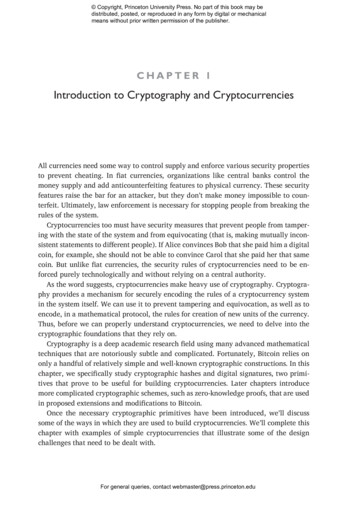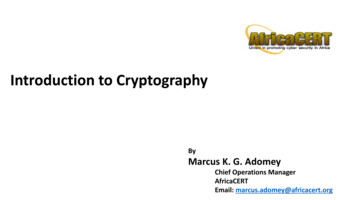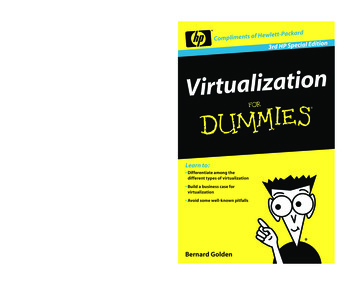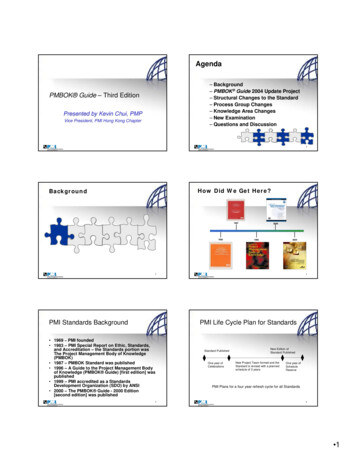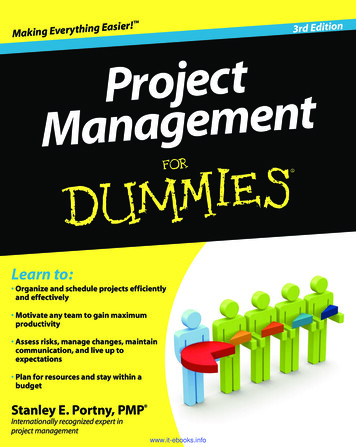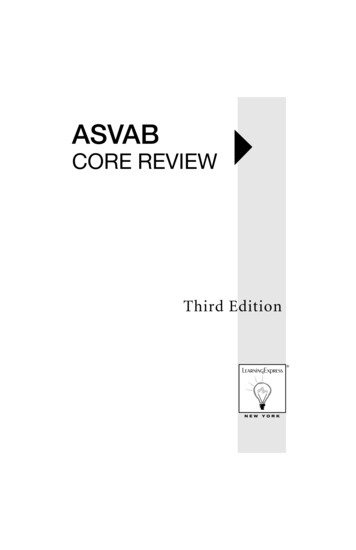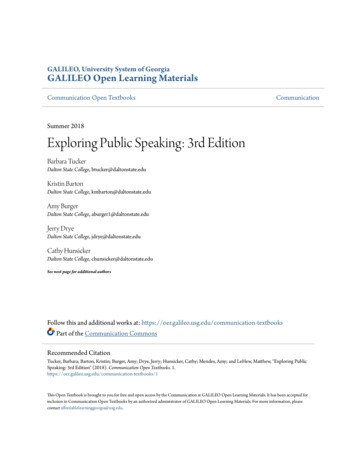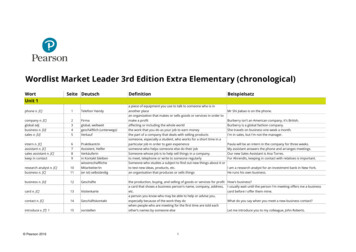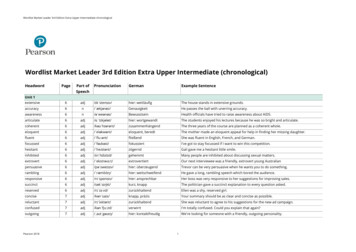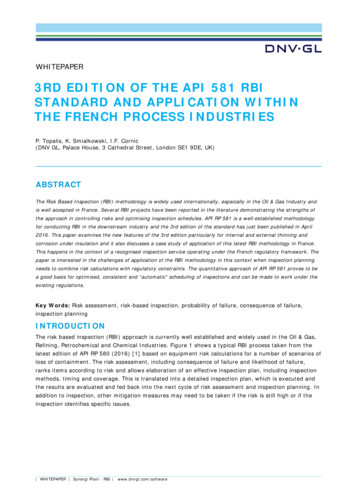
Transcription
Cryptography: An Introduction(3rd Edition)Nigel Smart
Preface To Third EditionThe third edition contains a number of new chapters, and various material has been movedaround. The chapter on Stream Ciphers has been split into two. One chapter now deals withthe general background and historical matters, the second chapter deals with modernconstructions based on LFSR’s. The reason for this is to accomodate a major new sectionon the Lorenz cipher and how it was broken. This compliments the earlier section on thebreaking of the Enigma machine. I have also added a brief discussion of the A5/1 cipher,and added some more diagrams to the discussion on modern stream ciphers. I have added CTR mode into the discussion on modes of operation for block ciphers. Thisis because CTR mode is becoming more used, both by itself and as part of more complexmodes which perform full authenticated encryption. Thus it is important that studentsare exposed to this mode. I have reordered various chapters and introduced a new part on protocols, in which wecover secret sharing, oblvious transfer and multi-party computation. This compliments thetopics from the previous edition of commitment schemes and zero-knowledge protocols,which are retained a moved around a bit. Thus the second edition’s Part 3 has now beensplit into two parts, the material on zero-knowledge proofs has now been moved to Part 5and this has been extended to include other topics, such as oblivious transfer and securemulti-party computation. The new chapter on secret sharing contains a complete description of how to recombineshares in the Shamir secret-sharing method in the presence of malicious adversaries. Toour knowledge this is not presented in any other elementary textbook, although it doesoccur in some lecture notes available on the internet. We also present an overview ofShoup’s method for obtaining threshold RSA signatures. A small section detailing the linkage between zero-knowledge and the complexity class N Phas been added.The reason for including extra sections etc, is that we use this text in our courses at Bristol, and sowhen we update our lecture notes I also update these notes. In addition at various points studentsdo projects with us, a number of recent projects have been on multi-party computation and hencethese students have found a set of notes useful in starting their projects. We have also introduceda history of computing unit in which I give a few lectures on the work at Bletchley.Special thanks for aspects of the third edition go to Dan Bernstein and Ivan Damgård, whowere patient in explaining a number of issues to me for inclusion in the new sections. Also thanksto Endre Bangerter, Jiun-Ming Chen, Ed Geraghty, Thomas Johansson, Georgios Kafanas, ParimalKumar, David Rankin, Berry Schoenmakers, S. Venkataraman, and Steve Williams for providingcomments, spotting typos and feedback on earlier drafts and versions.The preface to the second edition follows:3
Preface To Second EditionThe first edition of this book was published by McGraw-Hill. They did not sell enough towarrant a second edition, mainly because they did not think it worth while to allow people inNorth America to buy it. Hence, the copyright has returned to me and so I am making it availablefor free via the web.In this second edition I have taken the opportunity to correct the errors in the first edition, anumber of which were introduced by the typesetters. I have also used a more pleasing font to theeye (so for example a y in a displayed equation no longer looks somewhat like a Greek letter γ). Ihave also removed parts which I was not really happy with, hence out have gone all exercises andJava examples etc.I have also extended and moved around a large amount of topics. The major changes aredetailed below: The section on the Enigma machine has been extended to a full chapter. The material on hash functions and message authentication codes has now been placed ina seperate chapter and extended somewhat. The material on stream ciphers has also been extracted into a seperate chapter and beenslightly extended, mainly with more examples. The sections on zero-knowledge proofs have been expanded and more examples have beenadded. The previous treatment was slightly uneven and so now a set of examples ofincreasing difficulty are introduced until one gets to the protocol needed in the votingscheme which follows. A new chapter on the KEM/DEM method of constructing hybrid ciphers. The chapterdiscusses RSA-KEM and the discussion on DHIES has been moved here and now uses theGap-Diffie–Hellman assumption rather than the weird assumption used in the original. Minor notational updates are as follows: Permutations are now composed left to right, i.e.they operate on elements “from the right”. This makes certain things in the sections onthe Enigma machine easier on the eye.One may ask why does one need yet another book on cryptography? There are already plentyof books which either give a rapid introduction to all areas, like that of Schneier, or one whichgives an encyclopedic overview, like the Handbook of Applied Cryptography (hereafter called HAC ).However, neither of these books is suitable for an undergraduate course. In addition, the approachto engineering public key algorithms has changed remarkably over the last few years, with the adventof ‘provable security’. No longer does a cryptographer informally argue why his new algorithm issecure, there is now a framework within which one can demonstrate the security relative to otherwell-studied notions.Cryptography courses are now taught at all major universities, sometimes these are taught inthe context of a Mathematics degree, sometimes in the context of a Computer Science degree andsometimes in the context of an Electrical Engineering degree. Indeed, a single course often needsto meet the requirements of all three types of students, plus maybe some from other subjects whoare taking the course as an ‘open unit’. The backgrounds and needs of these students are different,some will require a quick overview of the current algorithms in use, whilst others will want anintroduction to the current research directions. Hence, there seems to be a need for a textbook5
6PREFACE TO SECOND EDITIONwhich starts from a low level and builds confidence in students until they are able to read, forexample HAC without any problems.The background I assume is what one could expect of a third or fourth year undergraduate incomputer science. One can assume that such students have met the basics of discrete mathematics(modular arithmetic) and a little probability before. In addition, they would have at some pointdone (but probably forgotten) elementary calculus. Not that one needs calculus for cryptography,but the ability to happily deal with equations and symbols is certainly helpful. Apart from that Iintroduce everything needed from scratch. For those students who wish to dig into the mathematicsa little more, or who need some further reading, I have provided an appendix (Appendix A) whichcovers most of the basic algebra and notation needed to cope with modern public key cryptosystems.It is quite common for computer science courses not to include much of complexity theory orformal methods. Many such courses are based more on software engineering and applications ofcomputer science to areas such as graphics, vision or artificial intelligence. The main goal of suchcourses is in training students for the workplace rather than delving into the theoretical aspectsof the subject. Hence, I have introduced what parts of theoretical computer science I need, asand when required. One chapter is therefore dedicated to the application of complexity theory incryptography and one deals with formal approaches to protocol design. Both of these chapters canbe read without having met complexity theory or formal methods before.Much of the approach of the book in relation to public key algorithms is reductionist in nature.This is the modern approach to protocol design and this differentiates the book from other treatments. This reductionist approach is derived from techniques used in complexity theory, where oneshows that one problem reduces to another. This is done by assuming an oracle for the secondproblem and showing how this can be used to solve the first. At many places in the book cryptographic schemes are examined from this reductionist approach and at the end I provide a quickoverview of provable security.I am not mathematically rigorous at all steps, given the target audience, but aim to give aflavour of the mathematics involved. For example I often only give proof outlines, or may notworry about the success probabilities of many of our reductions. I try to give enough of the gorydetails to demonstrate why a protocol has been designed in a certain way. Readers wishing a morein-depth study of the various points covered or a more mathematically rigorous coverage shouldconsult one of the textbooks or papers in the Further Reading sections at the end of each chapter.On the other hand we use the terminology of groups and finite fields from the outset. This is fortwo reasons. Firstly, it equips students with the vocabulary to read the latest research papers, andhence enables students to carry on their studies at the research level. Secondly, students who donot progress to study cryptography at the postgraduate level will find that to understand practicalissues in the ‘real world’, such as API descriptions and standards documents, a knowledge of thisterminology is crucial. We have taken this approach with our students in Bristol, who do not haveany prior exposure to this form of mathematics, and find that it works well as long as abstractterminology is introduced alongside real-world concrete examples and motivation.I have always found that when reading protocols and systems for the first time the hardestpart is to work out what is public information and which information one is trying to keep private.This is particularly true when one meets a public key encryption algorithm for the first time, orone is deciphering a substitution cipher. I have hence introduced a little colour coding into thebook, generally speaking items in red are secret and should never be divulged to anyone. Items inblue are public information and are known to everyone, or are known to the party one is currentlypretending to be.For example, suppose one is trying to break a system and recover some secret message m;suppose the attacker computes some quantity b. Here the red refers to the quantity the attacker
PREFACE TO SECOND EDITION7does not know and blue refers to the quantity the attacker does know. If one is then able to writedown, after some algebra,b · · · m,then it is clear something is wrong with our cryptosystem. The attacker has found out somethinghe should not.This colour coding will be used at all places where it adds something to the discussion. In othersituations, where the context is clear or all data is meant to be secret, I do not bother with thecolours.To aid self-study each chapter is structured as follows: A list of items the chapter will cover, so you know what you will be told about. The actual chapter contents. A summary of what the chapter contains. This will be in the form of revision notes, if youwish to commit anything to memory it should be these facts. Further Reading. Each chapter contains a list of a few books or papers from which furtherinformation could be obtained. Such pointers are mainly to material which you should beable to tackle given that you have read the prior chapter. Since further information onalmost any topic in cryptography can be obtained from reading HAC I do not include apointer to HAC in any chapter. It is left, as a general recommendation to the reader, tofollow up any topic in further detail by reading what HAC has to say.There are no references made to other work in this book, it is a textbook and I did not want tobreak the flow with references to this, that and the other. Therefore, you should not assume thatANY of the results in this book are my own, in fact NONE are my own. For those who wish toobtain pointers to the literature, you should consult one of the books mentioned in the FurtherReading sections, or you should consult HAC.The book is divided into four parts. Part 1 gives the mathematical background needed andcould be skipped at first reading and referred back to when needed. Part 2 discusses symmetrickey encryption algorithms and the key distribution problem that results from their use. Part 3discusses public key algorithms for encryption and signatures and some additional key conceptssuch as certificates, commitment schemes and zero-knowledge proofs. Part 5 is the most advancedsection and covers a number of issues at the more theoretical end of cryptography, including themodern notion of provable security. Our presentation of the public key algorithms in Part 3 hasbeen designed as a gentle introduction to some of the key concepts in Part 5. Part 5 should beconsidered a gentle, and non-rigorous, introduction to theoretical aspects of modern cryptography.For those instructors who wish to give a rapid introduction to modern cryptography, in a 20–30lecture course, I recommend Chapters 3, 7, 8, 10, 11, 14 and 16 with enough of Chapter 1 so asto enable the students to understand the following material. For those instructors wishing to usethis book to give a grounding in the mathematics required for modern public key cryptography (forexample a course aimed at Math Majors) then I suggest covering Chapters 3, 11, 12, 13 and 15.Instructors teaching an audience of Computer Scientists are probably advised to skip Chapters 2,12 and 13, since these chapters are more mathematical in nature.I would like to thank the students at Bristol who have commented on both our courses, theoriginal a draft of this book and the first edition. In addition the following people
for free via the web. In this second edition I have taken the opportunity to correct the errors in the first edition, a number of which were introduced by the typesetters. I have also used a more pleasing font to the eye (so for example a y in a displayed equation no longer looks somewhat like a Greek letter γ). I have also removed parts which I was not really happy with, hence out have gone .
